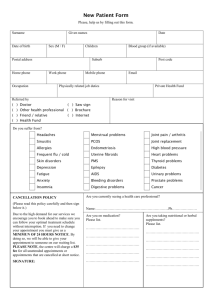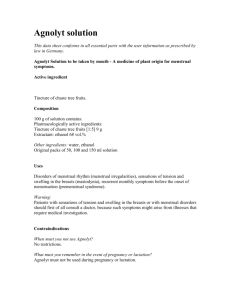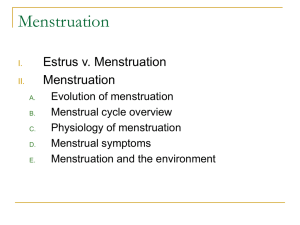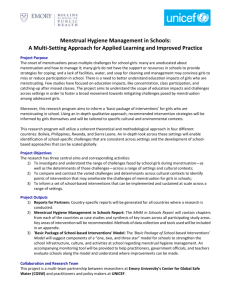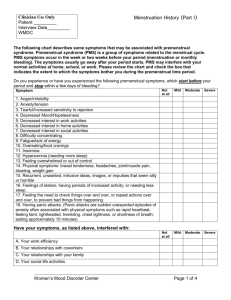blood indices during menstruation and late follicular phase of
advertisement
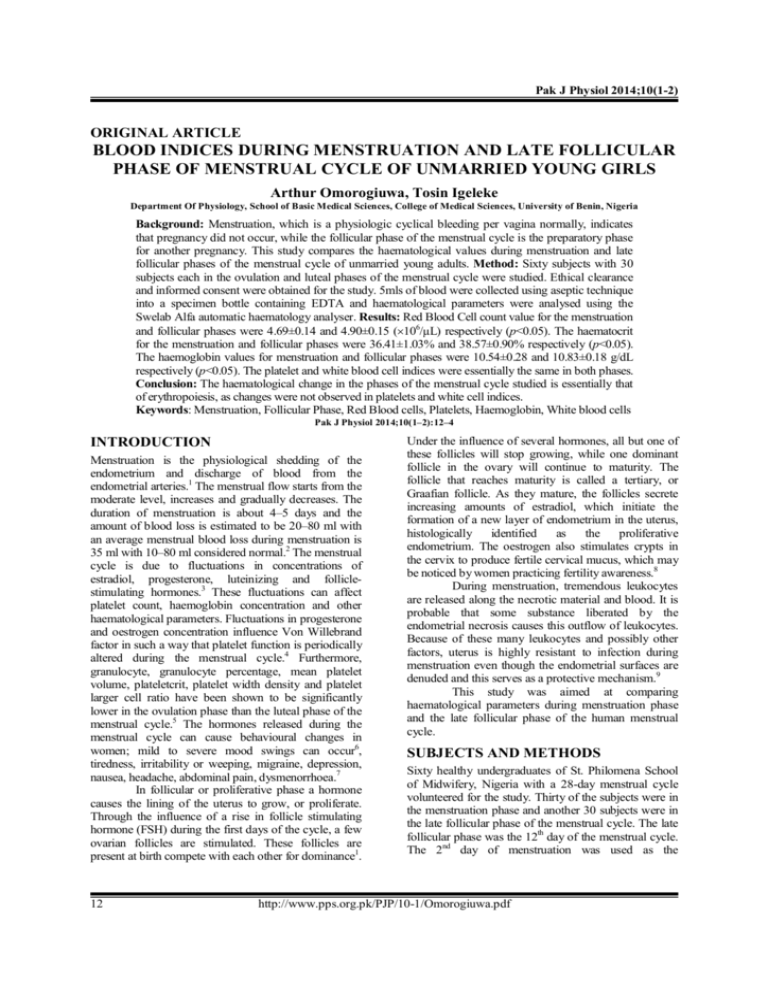
Pak J Physiol 2014;10(1-2) ORIGINAL ARTICLE BLOOD INDICES DURING MENSTRUATION AND LATE FOLLICULAR PHASE OF MENSTRUAL CYCLE OF UNMARRIED YOUNG GIRLS Arthur Omorogiuwa, Tosin Igeleke Department Of Physiology, School of Basic Medical Sciences, College of Medical Sciences, University of Benin, Nigeria Background: Menstruation, which is a physiologic cyclical bleeding per vagina normally, indicates that pregnancy did not occur, while the follicular phase of the menstrual cycle is the preparatory phase for another pregnancy. This study compares the haematological values during menstruation and late follicular phases of the menstrual cycle of unmarried young adults. Method: Sixty subjects with 30 subjects each in the ovulation and luteal phases of the menstrual cycle were studied. Ethical clearance and informed consent were obtained for the study. 5mls of blood were collected using aseptic technique into a specimen bottle containing EDTA and haematological parameters were analysed using the Swelab Alfa automatic haematology analyser. Results: Red Blood Cell count value for the menstruation and follicular phases were 4.69±0.14 and 4.90±0.15 (106/µL) respectively (p<0.05). The haematocrit for the menstruation and follicular phases were 36.41±1.03% and 38.57±0.90% respectively (p<0.05). The haemoglobin values for menstruation and follicular phases were 10.54±0.28 and 10.83±0.18 g/dL respectively (p<0.05). The platelet and white blood cell indices were essentially the same in both phases. Conclusion: The haematological change in the phases of the menstrual cycle studied is essentially that of erythropoiesis, as changes were not observed in platelets and white cell indices. Keywords: Menstruation, Follicular Phase, Red Blood cells, Platelets, Haemoglobin, White blood cells Pak J Physiol 2014;10(1–2):12–4 INTRODUCTION Menstruation is the physiological shedding of the endometrium and discharge of blood from the endometrial arteries.1 The menstrual flow starts from the moderate level, increases and gradually decreases. The duration of menstruation is about 4–5 days and the amount of blood loss is estimated to be 20–80 ml with an average menstrual blood loss during menstruation is 35 ml with 10–80 ml considered normal.2 The menstrual cycle is due to fluctuations in concentrations of estradiol, progesterone, luteinizing and folliclestimulating hormones.3 These fluctuations can affect platelet count, haemoglobin concentration and other haematological parameters. Fluctuations in progesterone and oestrogen concentration influence Von Willebrand factor in such a way that platelet function is periodically altered during the menstrual cycle.4 Furthermore, granulocyte, granulocyte percentage, mean platelet volume, plateletcrit, platelet width density and platelet larger cell ratio have been shown to be significantly lower in the ovulation phase than the luteal phase of the menstrual cycle.5 The hormones released during the menstrual cycle can cause behavioural changes in women; mild to severe mood swings can occur6, tiredness, irritability or weeping, migraine, depression, nausea, headache, abdominal pain, dysmenorrhoea.7 In follicular or proliferative phase a hormone causes the lining of the uterus to grow, or proliferate. Through the influence of a rise in follicle stimulating hormone (FSH) during the first days of the cycle, a few ovarian follicles are stimulated. These follicles are present at birth compete with each other for dominance1. 12 Under the influence of several hormones, all but one of these follicles will stop growing, while one dominant follicle in the ovary will continue to maturity. The follicle that reaches maturity is called a tertiary, or Graafian follicle. As they mature, the follicles secrete increasing amounts of estradiol, which initiate the formation of a new layer of endometrium in the uterus, histologically identified as the proliferative endometrium. The oestrogen also stimulates crypts in the cervix to produce fertile cervical mucus, which may be noticed by women practicing fertility awareness.8 During menstruation, tremendous leukocytes are released along the necrotic material and blood. It is probable that some substance liberated by the endometrial necrosis causes this outflow of leukocytes. Because of these many leukocytes and possibly other factors, uterus is highly resistant to infection during menstruation even though the endometrial surfaces are denuded and this serves as a protective mechanism.9 This study was aimed at comparing haematological parameters during menstruation phase and the late follicular phase of the human menstrual cycle. SUBJECTS AND METHODS Sixty healthy undergraduates of St. Philomena School of Midwifery, Nigeria with a 28-day menstrual cycle volunteered for the study. Thirty of the subjects were in the menstruation phase and another 30 subjects were in the late follicular phase of the menstrual cycle. The late follicular phase was the 12th day of the menstrual cycle. The 2nd day of menstruation was used as the http://www.pps.org.pk/PJP/10-1/Omorogiuwa.pdf Pak J Physiol 2014;10(1-2) menstruation phase. Subjects with a 28-day cycle were subjects who had consistently had a 28-day menstrual cycle in the last 6 months preceding the study. Subjects who were on oral contraceptives were excluded from the study. Ethical clearance was obtained from the Ethics and Collaboration Committee of St. Philomana Catholic Hospital, Nigeria. Informed consent was also obtained from the subjects for the study. Blood samples were collected under aseptic conditions from the ante-cubital vein by venepuncture into a specimen bottle containing the anticoagulant Ethylene Diamine Tetra acetic Acid (EDTA). Blood samples were analysed within 1–2 hours of collection using the Swelab Alfa automatic hematology analyser. The analyser examined samples for Red Blood Cells counts (RBC), Mean Corpuscular Volume (MCV), Red Density Width (RDWa), Red Density Width Percentage (RDW%), Haematocrit (Hct), Platelet count (PLT), Mean Platelet Volume (MPV), Platelet Density Width (PDW), Plateletcrit (PCT), Platelet Larger Cell Ratio (LPCR), White Blood Cells (WBC), Haemoglobin Concentration (HGB), Mean Corpuscular Haemoglobin (MCH), Mean Concentration Haemoglobin Concentration (MCHC), Lymphocyte (LYM), Granulocyte (GRAN), Mid Sized Cells (MID), Lymphocyte Percentage (LYM %), Granulocyte Percentage (GRAN %), and Mixed Sized Density Percentage (MID %). Results were presented in Mean±SEM. Independent sample t-test was used to compare means of haematological values for the menstrual and follicular phases of the study groups and p<0.05 was considered significant. RESULTS Table-1 gives the red blood cell indices in the menstruation and follicular phases of the menstrual cycle. While Table-2 and 3 depict the white cell and platelet indices respectively Table-1: Red Blood Cell and its indices during Menstruation and Follicular Phase Menstruation Parameters phase Red Blood Cells Counts 4.69±0.14 (106/µL) Mean Corpuscular Volume 77.80±1.97 (MCV) (fL) Red Density Width 57.73±1.43 (RDWa) (fL) Red Density Width Percentage 11.70±0.42 (RDW%) Haematocrit 36.41±1.03 (%) Haemoglobin Concentration 10.54±0.28 (Hb) (g/dl) Mean Corpuscular Haemoglobin 22.60±0.66 (MCH) (Pg) Mean Corpuscular Haemoglobin 29.04±0.33 Concentration (MCHC) (g/dl) *significant Follicular phase p 4.90±0.15 0.01* 79.20±1.73 0.90 59.11±1.62 0.25 11.75±0.41 0.58 38.57±0.90 0.00* 10.83±0.18 0.03* 22.32±0.17 0.35 28.14±0.39 0.42 Table-2: White Blood cell and its indices during Menstruation and Follicular Phase Parameters White Blood Cells (WBC) (103/µL) Lymphocyte (LYM) Granulocyte (GRAN) Lymphocyte Percentage (LYM %) Granulocyte Percentage (GRAN %) Mid Sized Cells (MID) Mixed Sized Density Percentage (MID %) Menstruation Follicular phase phase p 4.52±0.24 4.73±0.33 0.39 2.07±0.14 2.10±0.15 0.56 2.12±0.19 2.23±0.29 0.81 46.74±2.67 46.50±3.31 0.94 47.05±2.62 46.54±3.02 0.85 0.33±0.44 0.38±0.06 0.16 6.21±0.52 6.99±0.64 0.30 *significant Table-3: Platelets parameters and its indices during Menstruation and Follicular Phase Parameters Platelet Count (PLT) (103/ µL) Mean Platelet Volume (MPV) Plateletcrit (PCT) Platelet Density Width (PDW) Platelet Larger Cell Ratio (LPCR) Menstruation Follicular phase phase p 209.1±21.45 208.7±22.92 0.98 7.63±0.16 7.87±0.28 0.10 0.16±0.01 0.16±0.01 0.00 11.48±0.32 11.80±0.55 0.30 15.50±1.35 16.55±1.93 0.24 *significant DISCUSSION Haematological and biochemical parameters are indicators of health and nutritional status of a woman and in turn affect her reproductive capability. The effect of menstruation alongside several factors such as female sex hormones –oestrogen and progesterone interplays and could possibly affect haematological parameters. The changes in concentration of the female sex hormones during each phase of the menstrual cycle contribute to the variation in haematological parameters. From initially low levels during the menstrual phase, oestrogen levels begin to rise gradually and peak towards the end of the follicular phase.9 During the ovulatory phase of the menstrual cycle, the level of oestrogen falls while that of progesterone begins to rise. Both hormones rise again with progesterone now reaching peak level during the luteal phase. Oestrogens exert several effects that could reduce haemoglobin concentration and thus the haematocrit values. Oestrogens cause fluid retention, depress erythropoietin synthesis and reduce the bone marrow response to available erythropoietin. However, progesterone antagonises these effects.10 In some studies, there is a non-significant difference in the haemoglobin concentration, red blood cell concentration and haematocrit during the http://www.pps.org.pk/PJP/10-1/Omorogiuwa.pdf 13 Pak J Physiol 2014;10(1-2) menstruation and follicular phase of the menstrual cycle.11 The significant difference in haemoglobin concentration may be due to increased erythropoiesis to compensate for the loss of blood during menstruation. Studies also show that there can be increase in red blood cell count and haemoglobin concentration from the early menstruation phase until the post ovulatory phase with a subsequent decline towards the end of the menstrual cycle.12 The red blood cell count was reported to have been decreased during menstruation causing a decrease in the ratio of red blood cells to plasma. Hence, there is increase in rouleaux formation and Erythrocyte Sedimentation Rate after menstruation.13 Some studies show significant difference in haematocrit and Erythrocyte Sedimentation Rate in the menstrual cycle.14 This study revealed that the red blood cell indices show a significant decrease during menstruation compared to the late follicular phase of the cycle. However, studies on the white cell indices are divergent; while some studies show no significant changes in total white blood cell count during various phases of menstrual cycle15,16 others show increased total white blood cell count from menstrual phase to the secretory phase17, increased leucocyte count during the mid-cycle, and decreases during the secretory phase.18 This study is consistent with the report that there is no change in circulating leucocytes during the menstrual cycle. Although it has been reported that platelet count significantly increased during proliferative phase, due to stress and release of corticosteroids19, platelet count and its indices during the menstruation and follicular phase of the menstrual cycle showed no significance differences. There is significant difference in red blood cell count, haematocrit and haemoglobin concentration. REFERENCES 1. 2. 3. 4. 5. 6. 7. 8. 9. 10. 11. 12. 13. 14. 15. 16. CONCLUSION During menstruation and late follicular phase there is a significant difference in the red blood cell count, haemoglobin concentration and haematocrit values. These changes may be due to increased erythropoiesis to compensate for the loss of blood during menstruation. 17. 18. 19. Raven PH Losos JB, Johnson GB, Singer SR. Textbook of Biology. 9th ed. New York: McGraw-Hill; 2013.pp. 1212–5. Dutta DC. Textbook of Gynaecology. 6th ed. London: New Central Book Agency (P) Ltd; 2013.pp 80–95. Agboola A. A Textbook of Obstetrics and Gynecology for Medical Students. 2nd ed. Nigeria Plc: Heinemann Educational Books; 2006. pp. 24–6. Drici MD, Burklow TR, Haridasse V. Sex hormones prolong the QT interval and down regulate potassium channel expression in the rabbit heart. Circulation1996;94:1471–4. Omorogiuwa A, Egbeluya EE. A Comparative study of the hematological values in the ovulation and luteal phases of the menstrual cycle. Int J Biol Chem Sci 2014;8(4):1853–8. Schmidt PJ, Nieman LK, Danaceau MA, Adams LF, Rubinow DR. Differential behavioral effects of gonadal steroids in women with and in those without premenstrual syndrome. N Eng J Med 1998;338(4):209–16. Giannini AZ, Price WA, Loiselle RH. Beta-Endorphin withdrawal: a possible cause of premenstrual tension syndrome. Int J Psychophysiol 1984;1(4):341–3. Weschler T. Taking charge of our fertility. Revised ed. New York: Harper Collins; 2002.pp. 359–61. Guyton AC, Hall JE. Textbook of Medical Physiology. 10th ed. New York: WB Saunders Company; 2012.pp. 392-937. Adamson JW, Dale DC, Klebanuff SJ. Hormones and the formed element of the blood. In: Williams RH (Ed). Textbook of Endocrinology. 5th ed. Philadelphia: WB Saunders Company;1981.pp. 223–9. Rajnee VKC, Raghuveer C, Bijendra K, Binawara SC. Haematological and electrocardiographic variations during menstrual cycle. Pak J Physiol 2010;6(1):18–21. Harewood WJ, Gillin A, Hennessy A, Armitstead J, Horvath JS, Tiller DJ. The effects of the menstrual cycle, pregnancy and early lactation on haematology and plasma biochemistry in the baboon (Papio hamadryas). J Med Primatol 2000;29(6):415–20. Korubo O, Dapper T, Emakpor AC. The effect of cigarette smoking on some haematological parameters. Niger Med Pract 1997;33:52–5. Dapper DVB, Didia BC. Haematological changes during the menstrual cycle. East Afr Med J 2002;79(4):181–3. Pathak NR, Desai CA, Chandwani S. Hematological changes during normal menstrual cycle. Indian J Physiol Pharmacol 1981;25(4):440. Makinoda S, Mikuni M, Sogame M, Kobamastsu Y, Yamada H, Yamamoto R, et al. Erythropoietin, granulocyte-colony stimulating factor, interlukin-1 beta and interlukin-6 during the menstrual cycle. Int J Gyanecol Obstet 1996;55:265–71. Bouman A, Moes H, Heineman MJ, de Leij LF, Faas MM. The immune responses during the luteal phase of the ovarian cycle: increasing sensitivity of human monocytes to endotoxin. Fertil Steril 2001;(76):555–9. Bain BJ, England JM. Variations in leucocyte count during menstrual cycle. Br Med J 1975;2:47–50. Clerici C. Modifications of respiratory function during pregnancy. Rev Pneumol Clin 1999;55:307–11. [Article in French] Address for Correspondence: Dr. Omorogiuwa Arthur, Department of Physiology, School of Basic Medical Sciences, College of Medical Sciences, University of Benin, Nigeria. Tel: +234-703-9460340 Email: ask4ade2006@yahoo.com 14 http://www.pps.org.pk/PJP/10-1/Omorogiuwa.pdf


